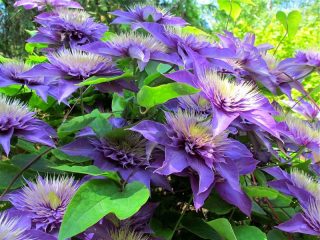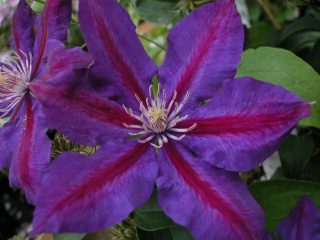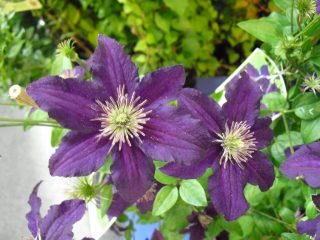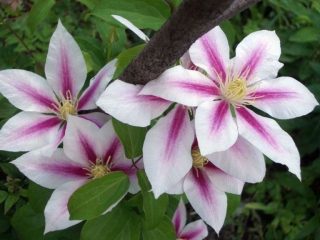Content
Clematis Anna German surprises gardeners with numerous graceful flowers. Liana does not need scrupulous care and pleases the eye throughout the summer.
Description of clematis Anna German
The variety was bred by Russian breeders and named after a famous person. Characteristic features of the variety:
- Height - 2-2.5 m.
- The flowers are large, light purple. Diameter - 12-20 cm. There is a white line in the center of all 7 petals. The stamens are yellow.
- The flowering period is May-June, August-September.
Liana is woven with leaf stalks and is intended to be grown near supports or trellises. Below is a photo of large-flowered clematis of the Anna German variety.
Clematis trimming group Anna German
Pruning is the most important manipulation in growing vines. However, before grabbing the tool and removing what you like, you need to remember the features of the Anna German variety. The plant blooms on young and last year's shoots. The variety belongs to the 2nd pruning group. Therefore, clematis must be carefully prepared for winter so that it does not freeze out.
Pruning and preparation is carried out as follows:
- All damaged, dry and poorly developed shoots are removed. In winter, the vine should go with 10-12 strong shoots.
- The plant is pruned to a height of 1.5 m, leaving 10-15 knots. For pruning, use only a sharp, disinfected knife or pruner.
- Shoots are collected in a bunch and twisted.
- The formed ring is covered with spruce branches, sawdust, weathered peat. The layer of insulation should not be too thick, otherwise air will not flow to the plant and it will vomit.
Anna German carries out a strong anti-aging pruning of hybrid clematis once every 5 years.
Planting and caring for clematis Anna German
The plant is planted in early autumn or spring, when the soil has completely thawed. Planting on the eve of cold weather is preferable: a flower planted in spring stops in development and actively begins to grow only after a year.
Clematis Anna German is planted as follows:
- Dig a hole with a diameter and depth of 60 cm.
- A layer of small pebbles or broken bricks is laid on the bottom.
- They make a mound from a mixture of humus and fertile soil in the form of a mound.
- Place the seedling in the center and spread the roots to the sides.
- They fill up the missing earth and tamp it. Depending on the degree of development of the plant, the root collar is deepened by 3-8 cm.
- Pour with a bucket of water.
- To protect a fragile plant, a screen is placed on the sunny side.
- Install the support.
Caring for clematis varieties Anna German begins in early spring and consists of the following manipulations:
- watering and feeding;
- mulching and weeding.
Watering
The roots lie deep underground, so clematis of the Anna German variety is watered abundantly at the root 4-8 times a month. Due to the frequent wetting of the central part of the plant, fungal diseases can develop. 1 bucket of water is added under young plants (up to 3 years old), and under adults - 2-3 buckets.
Mulching and weeding
To slow the evaporation of moisture and prevent growth weeds, the soil around the plant is covered with humus or peat. Weeding and loosening are carried out throughout the growing season as needed.
Top dressing
In early spring, adult clematis are fed with a mixture of ash and humus, mineral potassium-phosphorus fertilizers.For young plants, nutrients are applied in a small amount 1 time in 2 weeks.
In growing clematis Anna German, the most important thing is not to overdo it. Excessive watering or feeding will only worsen the condition of the vine or even destroy it.
Reproduction
Clematis can be propagated:
- seeds;
- layering;
- cuttings;
- dividing the bush.
Getting a new plant in the first way is quite problematic: the seed emerges for a long time and at different times. Therefore, if you need to grow a young specimen of the Anna German variety, it is better to use one of the other vegetative methods.
Clematis is propagated by layering as follows:
- A young shoot with a length of 20-30 cm is chosen and placed in a shallow ditch, leaving only the top on the surface.
- In the internode, the process is fixed with a bracket or stones.
- The regrown nodes are covered with soil.
- During the rooting period, the cuttings are regularly watered.
- In the spring, the new plant is separated from the mother and transplanted to a permanent place.
Cuttings begin at the beginning of the flowering period. Breeding scheme:
- A cutting with 1-2 internodes is cut from the middle of the shoot. There should be 2 cm above the top knot, and 3-4 cm below the bottom knot.
- The planting material is soaked in a growth stimulator solution for 16-24 hours.
- Cuttings are planted at an angle in containers filled with a mixture of sand and peat (1: 1).
- In order for the roots to grow faster, the temperature is maintained at +25aboutC. For this, the containers are covered with polyethylene or transferred to a greenhouse.
- The cuttings are sprayed with water at room temperature.
Clematis Anna German takes root in 1-2 months.
Diseases and pests
Clematis Anna German has high immunity. The main reasons for the development of any disease are improper care and adverse weather conditions. Due to waterlogging of the soil, rot or wilt (fungus) develops on the roots. Clematis patients with wilting dig up and carry them away from the site.
During the rainy season, to prevent the development of bacteria, the plant and the soil around it are sprayed with "Fitosporin", a weak solution of potassium permanganate.
Among the pests, the root system of clematis is affected by mice and bears. But most of all damage is caused by root knot nematode. This larva makes its way into the root of the flower and in a short time turns it into a shapeless mass. As a result, the plant stops growing and dies. Affected vines are destroyed, and the soil is treated with insecticides.
Conclusion
Clematis Anna German is a large-flowered variety with light purple hues. Despite the fact that the plant blooms twice, it does not require careful maintenance. You just need to plant clematis in an elevated, sunny area, provide regular watering and apply some fertilization.










